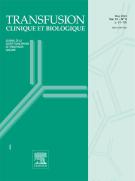Platelet demand forecasting based on the SARIMA model: optimizing blood bank resource allocation and clinical supply - 11/04/25

Highlights |
• | Effective demand prediction: The SARIMA(0,1,1)(0,1,1) ∼ 12 ∼ model demonstrated high accuracy in predicting platelet demand, achieving a mean relative error of 3.61%, with actual values falling within the 95% confidence interval. |
• | Seasonal adjustment: The model effectively captured seasonal fluctuations in platelet demand, using nine years of monthly data (2015–2023) to optimise blood bank inventory management. |
• | Practical Utility: Provides a data-driven tool for blood banks to align platelet collection and inventory strategies with clinical needs, reducing waste and ensuring supply security. |
• | Limitations and future directions: While robust to seasonal trends, the model struggles with sudden perturbations (e.g., COVID-19). Future integration of machine learning and real-time data is suggested to improve adaptability. |
• | Ethical and operational implications: Validated using deidentified historical data, the approach supports ethical resource allocation and cost efficiency in healthcare systems. |
Abstract |
Background |
With advances in medical technology and an aging population, the demand for single-donor platelet transfusions is increasing because of their significant therapeutic effects. However, the short shelf-life of platelets and the lack of large-scale reserves make accurate demand forecasting crucial for blood bank inventory management, resource allocation and clinical supply.
Objective |
This study aims to forecast platelet demand trends via time series analysis, specifically the SARIMA model, to provide scientific evidence for blood banks, optimize resource allocation and improve clinical supply efficiency.
Methods |
Monthly aggregate data from type A BPC units supplied by Huzhou Central Blood Station from January 2015 to December 2023 were collected. By analyzing these data, a SARIMA model was constructed to predict platelet demand in the first half of 2024.
Results |
The SARIMA(0,1,1)(0,1,1)12 model performed best in terms of goodness of fit and Bayesian information criterion (BIC) tests and accurately predicted platelet demand. The predicted results revealed that the actual monthly supply in the first half of 2024 was within the 95% confidence interval of the forecast, with a mean relative error of 3.61%.
Conclusion |
The SARIMA model effectively predicts platelet demand, providing a practical tool for blood banks to optimize inventory management and clinical supply. Future research should explore further optimizations and improvements to better serve clinical needs and resource management.
Le texte complet de cet article est disponible en PDF.Keywords : SARIMA model, Platelet demand forecasting, Time series analysis, Seasonal factors, Blood management
Plan
Bienvenue sur EM-consulte, la référence des professionnels de santé.
L’accès au texte intégral de cet article nécessite un abonnement.
Déjà abonné à cette revue ?

